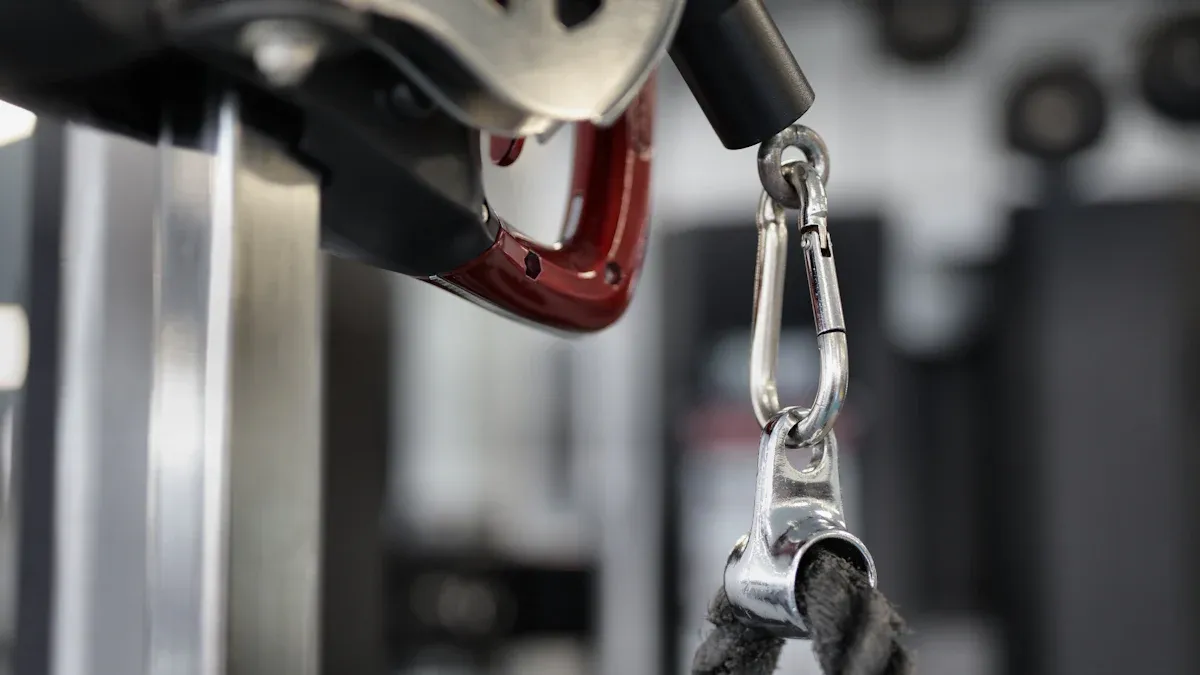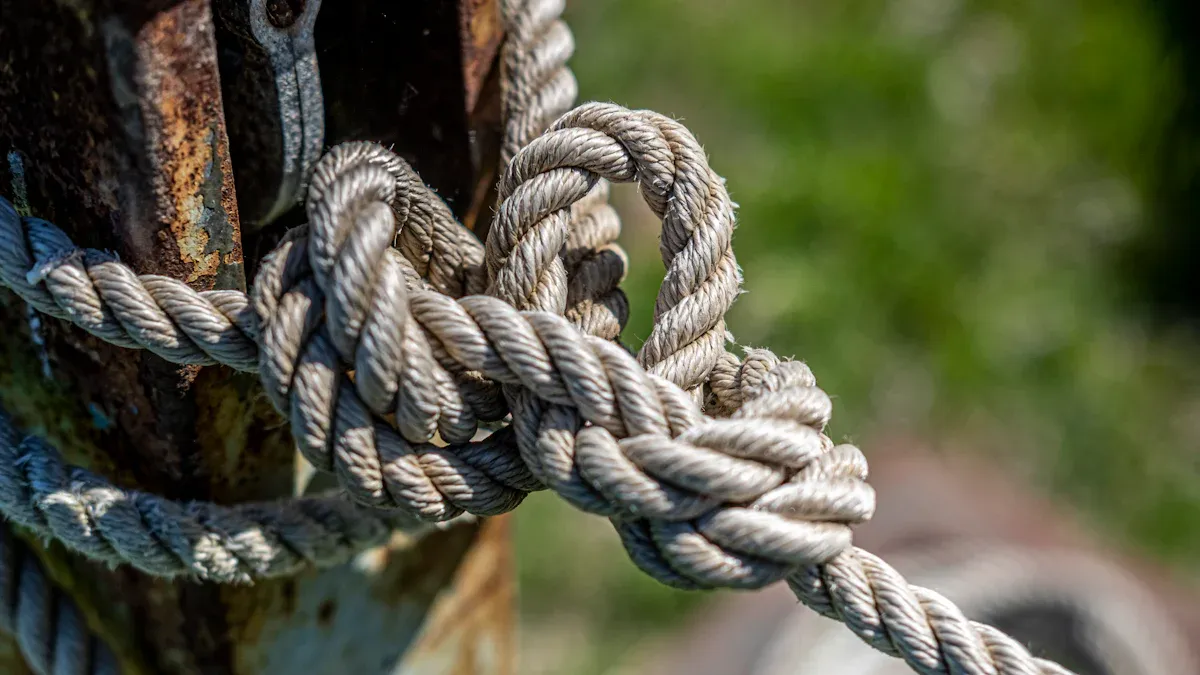
I have always been impressed by how heavy duty stainless steel cable ties can handle immense loads. These ties, crafted with high tensile strength, securely hold up to 350 pounds. Their ability to resist extreme temperatures and environmental factors ensures durability. When installed correctly, they provide unmatched reliability for demanding applications.
Key Takeaways
- Strong stainless steel cable ties can hold 350 pounds. They work well in tough industrial and marine jobs.
- Picking the right type of stainless steel is important. Use 304 for normal jobs and 316 for tough, wet places. This helps them last longer and resist rust.
- Installing them correctly makes them work better and last longer. Use a cable tie gun and pull with even pressure.
Tensile Strength and Material Composition of Heavy Duty Stainless Steel Cable Ties

Tensile Strength and Weight Capacity
When I think about the strength of heavy duty stainless steel cable ties, their ability to hold up to 350 pounds stands out. This impressive capacity stems from their high tensile strength, which ensures they can withstand significant force without breaking. These ties are specifically engineered for demanding applications where reliability is non-negotiable.
Unlike plastic alternatives, metal zip ties, including those made of stainless steel, offer superior strength and resistance. They are designed to handle heavy loads while maintaining their structural integrity. This makes them ideal for securing large objects or bundles in industrial, construction, and even marine environments. Their performance remains consistent, even under extreme stress, which is why I always recommend them for heavy-duty tasks.
Tip: Always check the tensile strength rating of the cable ties before use to ensure they meet the requirements of your specific application.
Role of Material Composition in Performance
The material composition of heavy duty stainless steel cable ties plays a crucial role in their performance. Stainless steel, known for its exceptional durability and resistance to environmental factors, ensures these ties perform reliably in harsh conditions. Let me break down how different grades of stainless steel contribute to their effectiveness:
| Material Grade | Corrosion Resistance | Cost-Effectiveness | Ideal Use Case |
|---|---|---|---|
| 304 | Good | Cost-effective | General use |
| 316 | Excellent | Higher cost | Harsh environments (marine, chemical) |
| 201/430 | Inferior | Lower cost | Rarely used |
| 316L | Excellent | Higher cost | Applications requiring low carbon and traceability |
From my experience, 304 stainless steel is a versatile choice for most applications, offering a balance of strength and affordability. For environments exposed to saltwater or chemicals, 316 or 316L stainless steel is the better option due to its superior corrosion resistance. These material properties ensure the cable ties remain functional and secure, even in the most challenging conditions.
Additionally, stainless steel’s heat resistance and environmental durability make it a preferred choice over nylon or other materials. It performs exceptionally well in extreme temperatures, maintaining its strength and flexibility without degradation. This is why I trust stainless steel cable ties for both indoor and outdoor use, especially in demanding industrial settings.
Environmental Resistance and Durability

Corrosion Resistance in Stainless Steel Cable Ties
I have always appreciated the exceptional corrosion resistance of heavy duty stainless steel cable ties. Their design ensures they remain reliable even in the harshest environments. This resistance stems from the high chromium content in stainless steel, which reacts with oxygen to form a thin, stable oxide layer. This protective barrier prevents further corrosion and maintains the material’s integrity over time. For applications in salty or wet conditions, 316 stainless steel ties stand out due to the addition of molybdenum, which enhances their resistance to salt spray and aggressive chemicals.
These cable ties excel in outdoor and marine environments. They resist degradation from UV rays, extreme weather, and exposure to chemicals. I often recommend them for securing cables in offshore platforms, industrial plants, and other demanding locations. Their durability ensures they won’t crack, even in extreme cold or under prolonged sunlight.
| Feature | Description |
|---|---|
| Corrosion Resistant | Suitable for aggressive locations, including salt-spray resistant |
| Harsh & Hazardous Areas | Resistant to chemicals and salt spray for onshore and offshore applications |
Performance Across Temperature Extremes
The performance of stainless steel cable ties across temperature extremes is equally impressive. These ties maintain their strength and flexibility in both high-heat and freezing conditions. I’ve seen them perform flawlessly in industrial settings where temperatures fluctuate dramatically. Unlike nylon ties, which can become brittle in cold weather or soften in heat, stainless steel ties remain unaffected.
Their thermal resilience makes them ideal for environments exposed to fire, extreme heat, or sub-zero temperatures. For instance, in applications requiring secure fastening in furnaces or refrigeration units, these ties deliver consistent results. Their mechanical strength ensures they hold heavy loads without failure, even under thermal stress.
| Performance Category | Description |
|---|---|
| Mechanical | High loop tensile strength ensures secure fastening. |
| Thermal | Operates consistently across extreme temperature ranges. |
| Environmental | Resists corrosion and UV exposure. |
These qualities make stainless steel cable ties a reliable choice for industries requiring durability and performance under challenging conditions.
Advantages of Heavy Duty Stainless Steel Cable Ties Over Other Materials
Stainless Steel vs Nylon Cable Ties
When comparing stainless steel and nylon cable ties, I always consider their performance in demanding environments. Stainless steel cable ties excel in durability and strength, making them the preferred choice for heavy-duty applications. Here’s why:
- Stainless steel cable ties comply with strict safety regulations, making them suitable for industries like oil and gas, aerospace, and telecommunications.
- They withstand extreme temperatures, ranging from -328°F to 1000°F, without losing their structural integrity.
- Their resistance to environmental factors, such as UV rays and chemicals, ensures long-term reliability.
To illustrate the differences, here’s a quick comparison:
| Property | Nylon Cable Ties | Stainless Steel Cable Ties |
|---|---|---|
| Tensile Strength | Up to 175 lbs | 120 lbs |
| Temperature Range | -40°C to +85°C | -40°C to +110°C |
| UV Resistance | Yes | Yes |
| Reusable | Yes | No |
While nylon ties are lightweight and reusable, they lack the tensile strength and temperature resistance required for heavy-duty tasks. Stainless steel ties, on the other hand, provide unmatched reliability in challenging conditions.
Why Stainless Steel is Ideal for Heavy-Duty Applications
I have found stainless steel cable ties to be indispensable for heavy-duty applications. Their unique properties make them stand out in environments where strength and durability are critical. Here are some key reasons:
| Performance Characteristic | Description |
|---|---|
| Durability | Stainless steel ties reduce wear and tear caused by vibrations, enhancing cable longevity. |
| Mechanical Stress Resistance | 304 and 316-grade stainless steel maintain structural integrity under heavy loads. |
| Corrosion Resistance | The passive chromium oxide film protects against moisture and chemicals. |
| Secure Locking Mechanisms | Designed to prevent slippage, ensuring cables stay in place even in high-vibration settings. |
| Consistent Tension | Provides uniform pressure across cable bundles, minimizing loosening over time. |
These features make stainless steel cable ties the go-to solution for industries requiring robust and reliable fastening systems. Whether securing cables in industrial plants or bundling wires in marine environments, they deliver consistent performance. Their ability to endure mechanical stress and environmental challenges ensures they remain a trusted choice for professionals like me.
Proper Installation and Safety Considerations
Best Practices for Installing Heavy Duty Stainless Steel Cable Ties
Proper installation is critical to ensure the performance and longevity of heavy duty stainless steel cable ties. Over the years, I have learned that following best practices not only enhances reliability but also minimizes the risk of failure. Here are some key steps I always recommend:
- Choose the Right Tools: Use a high-quality stainless steel cable tie gun for precise tensioning and cutting. This prevents over-tightening, which can compromise the tie’s integrity.
- Inspect the Surface: Ensure the surface where the cable tie will be applied is clean and free of debris. This promotes a secure grip and reduces the risk of slippage.
- Position Correctly: Place the cable tie around the bundle or object, ensuring even distribution of pressure. Misalignment can lead to uneven tension and potential failure.
- Apply Consistent Tension: Use the cable tie gun to apply consistent tension. This ensures the tie is neither too loose nor too tight, maintaining its structural integrity.
- Trim Excess Material: After securing the tie, trim any excess material to prevent sharp edges that could cause injuries or damage nearby components.
To illustrate the effectiveness of these practices, here are some real-world case studies:
| Application | Results |
|---|---|
| Aerospace | Implemented a standardized stainless steel cable tie gun program, resulting in a 30% reduction in assembly time and improved consistency in wiring harness installations. |
| Marine Construction | Switched to high-grade stainless steel cable tie guns, leading to decreased maintenance requirements and improved longevity in corrosive environments. |
These examples highlight how proper tools and techniques can significantly improve efficiency and durability in demanding industries.
Tip: Always use cable ties that match the specific requirements of your application. For instance, select 316-grade stainless steel for marine environments to ensure maximum corrosion resistance.
Importance of Safety Margins in Load Capacity
Understanding and respecting safety margins is essential when working with heavy duty stainless steel cable ties. While these ties are designed to hold up to 350 pounds, I always recommend factoring in a safety margin to account for dynamic loads and environmental stresses.
For example, if a cable tie is rated for 350 pounds, I suggest limiting the load to 70-80% of its maximum capacity. This ensures the tie can handle unexpected stress without failure. Dynamic loads, such as vibrations or sudden movements, can exert additional force on the tie. By incorporating a safety margin, you reduce the risk of overloading and extend the tie’s lifespan.
Another critical consideration is the operating environment. High temperatures, corrosive substances, or prolonged UV exposure can affect the tie’s performance. Selecting the appropriate grade of stainless steel, such as 304 or 316, ensures the tie remains reliable under these conditions.
Note: Never exceed the manufacturer’s recommended load capacity. Doing so can compromise safety and lead to equipment failure.
By adhering to these guidelines, I have consistently achieved reliable and long-lasting results in various applications. Proper installation and respect for safety margins are not just best practices—they are essential for ensuring the performance and safety of heavy duty stainless steel cable ties.
Heavy duty stainless steel cable ties consistently deliver exceptional performance when used correctly. I’ve seen their ability to hold up to 350 pounds in various applications, such as with 14-inch and 26.7-inch ties designed for this tensile strength. Their durability, resistance to environmental factors, and proper installation make them a reliable choice for demanding tasks.
FAQ
What are the common applications of heavy duty stainless steel cable ties?
I often use these ties in industrial, marine, and construction settings. They secure heavy cables, pipes, and equipment in harsh environments requiring high durability and strength.
Can stainless steel cable ties be reused?
No, stainless steel cable ties are not reusable. Their locking mechanism ensures a secure hold, but it cannot be undone without cutting the tie.
How do I choose the right grade of stainless steel for my application?
I recommend 304 for general use and 316 for harsh environments like marine or chemical exposure. Each grade offers specific benefits based on its composition.
Tip: Always match the grade to your environment for optimal performance and longevity.
Post time: May-19-2025






